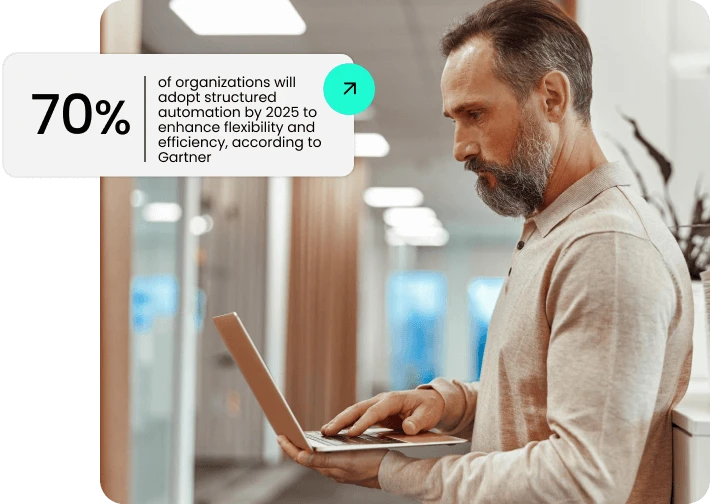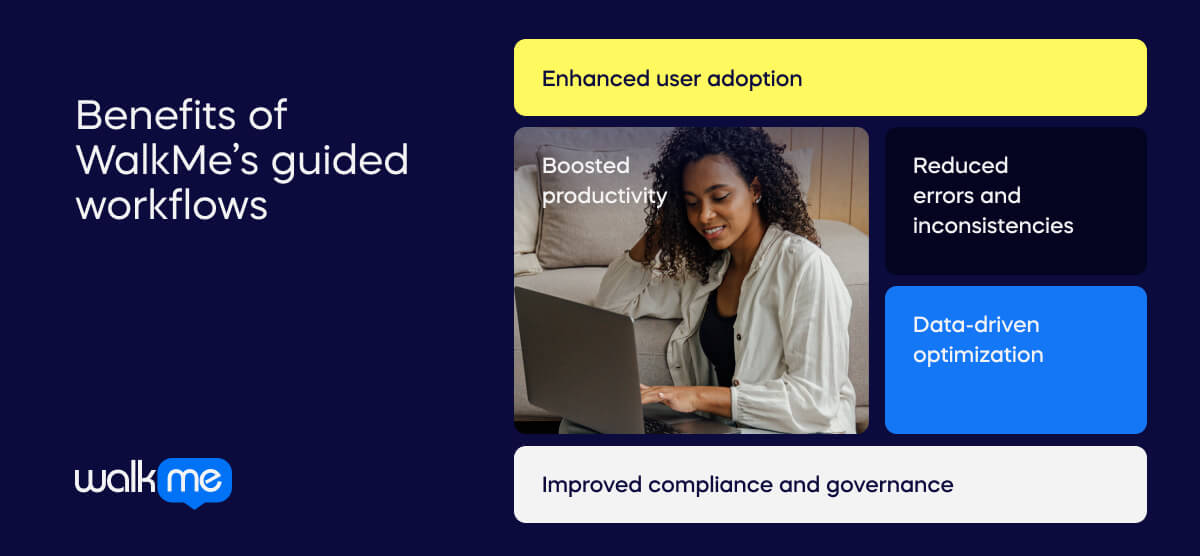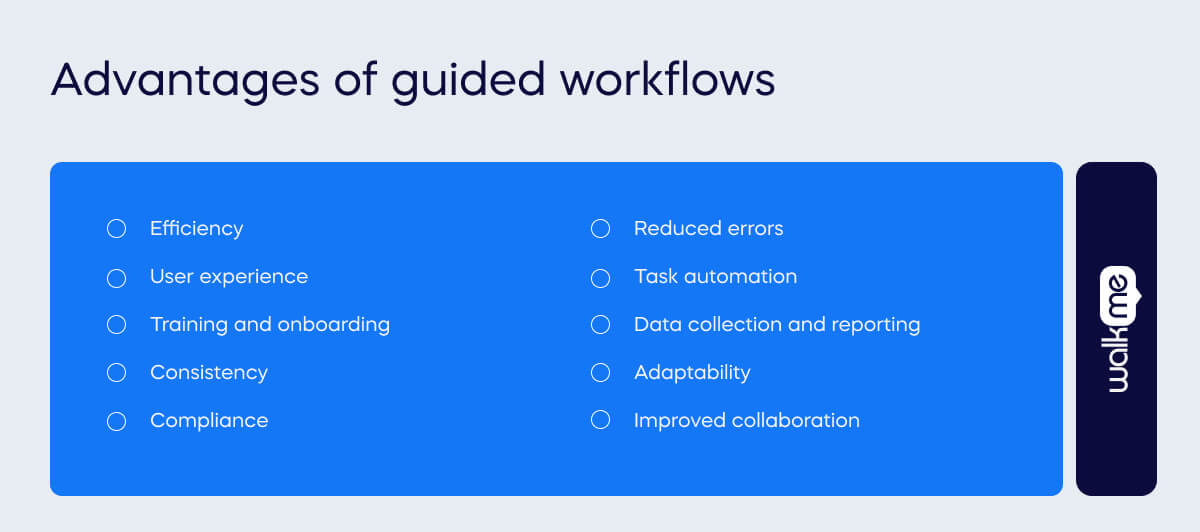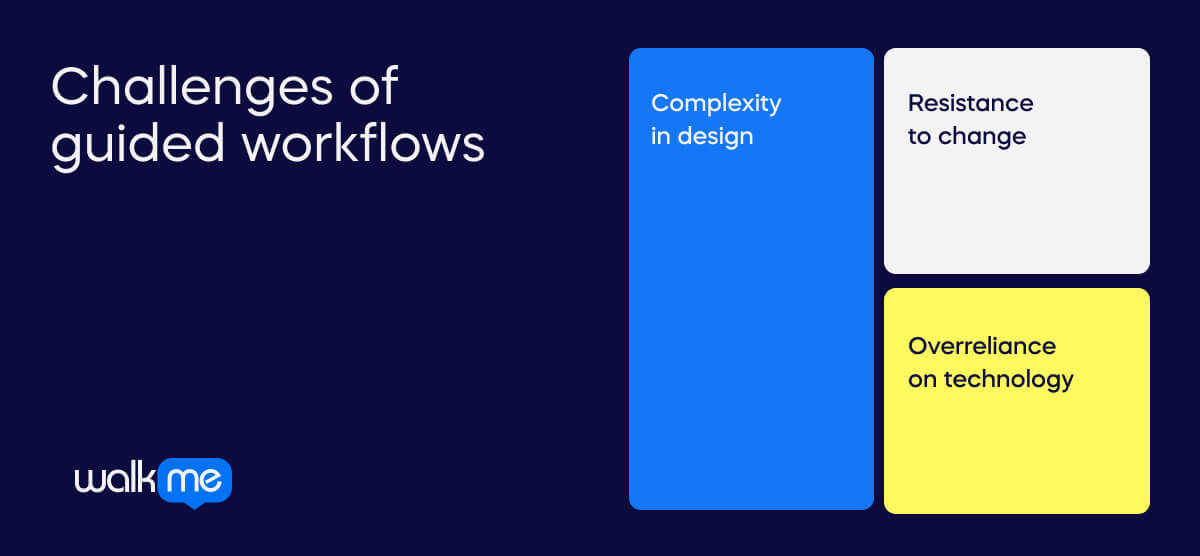What are guided workflows?
Guided workflows refer to a structured and directed sequence of steps or processes within a system or application designed to lead users through a specific task or activity.

Table of contents
These workflows are often implemented to improve efficiency, user experience, and overall productivity by providing people with clear instructions, prompts, or assistance at each step of the process.
Amidst the dynamic landscape of digital adoption platforms, guided workflows surface as an essential component, strategically emphasizing user proficiency over mere familiarity.
These platforms facilitate a seamless integration of advanced digital tools by providing users with step-by-step guidance, ensuring a user-friendly experience, and accelerating the adoption of new technologies within an organization.
Guided workflows in business serve as a catalyst for operational efficiency and employee empowerment.
By providing structured and intuitive processes, they enhance productivity, reduce errors, and empower the workforce to adapt to evolving technologies.
This transformative approach streamlines business operations and fosters a culture of continual improvement, propelling the workforce forward in the digital era.
mplementing guided workflows is an inevitable step for businesses as part of the wider integration of automation. According to Gartner, 70% of organizations will implement structured automation to boost flexibility and efficiency by 2025. This is a substantial increase from 20% of organizations in 2021.

The trend has been around for some time now. Forrester documented how spending on automation almost doubled between 2018 and 2010, growing from 6.7% of the IT budget to 11.2%.
Why are guided workflows important?
Within the digital space, WalkMe has carved a niche by empowering organizations with guided workflows.
These interactive roadmaps, seamlessly embedded within existing applications, revolutionize user experience and propel businesses toward success.
Benefits of WalkMe’s guided workflows

Here are some of the ways guided workflows from WalkMe positively impact businesses:
Enhanced user adoption
Imagine new hires navigating complex software with confidence, thanks to step-by-step guidance. Guided workflows eliminate confusion, shorten learning curves, and boost adoption rates, ensuring everyone maximizes the potential of available tools.
Boosted productivity
Repetitive tasks become a breeze with automated prompts and shortcuts. WalkMe streamlines workflows, minimizing wasted time and effort, empowering employees to focus on high-value activities. This translates to tangible productivity gains and a happier, more efficient workforce.
Reduced errors and inconsistencies
Human error is inevitable, but with guided workflows, WalkMe ensures accuracy and consistency in task execution, minimizing mistakes and safeguarding valuable data.
Improved compliance and governance
Regulatory compliance can be a labyrinth. WalkMe upholds ethical and legal standards by weaving checkpoints into workflows, mitigating risks, and fostering a culture of responsible action.
Data-driven optimization
WalkMe doesn’t just empower users; it gathers valuable data on their interactions. This data goldmine allows organizations to optimize workflows, prioritize features, and personalize the user experience, ensuring continuous improvement and lasting success.
How WalkMe’s guided workflows overcome challenges
WalkMe’s guided workflows also offer solutions to key hurdles within businesses:
Software complexity
Today’s software can be a labyrinth of features and functionalities that can easily overwhelm employees. Guided workflows tame this complexity, making even the most intricate programs accessible and user-friendly, regardless of technical expertise.
Remote work issues
With the rise of remote work, clear communication, and effective training become paramount. WalkMe bridges the physical gap by providing in-context guidance and support, ensuring remote employees stay productive and engaged, even when miles apart.
This is particularly important in the digital age – McKinsey research reveals that employee disengagement and attrition could cost a median-size S&P 500 company between $228 million and $355 million annually in lost productivity.
Change management problems
Implementing new software or processes can be met with resistance. Guided workflows act as gentle guides, easing users into change by providing familiar landmarks and step-by-step support, minimizing friction, and maximizing acceptance during the change management process.
Use cases for guided workflows
Guided workflows find practical applications across diverse contexts, leveraging their structured approach to enhance efficiency and user experience.
Guided workflows in business
Here are scenarios illustrating their active utilization in business:
Employee onboarding
In HR systems, guided workflows streamline the employee onboarding process. New hires are systematically guided through necessary steps such as paperwork submission, training modules, and introductions to team members, ensuring a smooth integration into the organization.
Sales pipeline management
CRM platforms employ guided workflows to optimize sales processes. Sales representatives are directed through lead qualification, contact management, and deal closure stages. This ensures standardized practices, reducing the likelihood of missed opportunities and improving overall sales performance.
Customer support ticket resolution
In customer support systems, guided workflows help agents resolve issues efficiently. Agents are guided through a series of steps, including issue identification, troubleshooting, and resolution documentation. This improves customer satisfaction and ensures consistency in support services.
IT service desk requests
IT service management platforms use guided workflows for handling service desk requests. Users reporting issues are guided through relevant information gathering, troubleshooting steps, and submission processes. This accelerates the problem resolution cycle and minimizes downtime.
Guided workflows with WalkMe
WalkMe offers several features and functionalities that seamlessly integrate with guided workflows, amplifying their power and enriching user experiences:
Smart walk-thrus
These interactive step-by-step guides appear directly on the user’s screen, leading them through specific tasks or processes. Think of them as GPS for software, providing clear directions and preventing users from getting lost in complex interfaces.
Launcher buttons
Place these customizable buttons strategically within any application to trigger relevant WalkMe content, offering contextual help at the user’s fingertips. No more hunting for manuals or scouring help desks!
Interactive elements
WalkMe goes beyond simple text instructions. Users can include quizzes, polls, and branching logic to personalize the workflow and adapt to individual user needs. Gamification elements can also be incorporated to boost engagement and make learning fun.
Task lists and checkpoints
Break down complex processes into manageable chunks with visually appealing task lists. Track progress and celebrate milestones to keep users motivated and ensure successful completion.
Shoutouts and spotlight tours
Highlight important features or updates with engaging notifications and temporary overlays. These quick bursts of information provide users with just-in-time learning without disrupting their workflow.
Integrations
Connect WalkMe with other tools like CRM systems or HR platforms to create a holistic ecosystem of user support. Streamline information flow and personalize workflows based on data from other sources.
Automation and AI
Take your workflows to the next level with automation. WalkMe can automatically fill forms, navigate menus, and even trigger actions, saving users time and effort. AI-powered features further personalize the experience and anticipate user needs.
Examples of guided workflows
With rapidly evolving organizational processes, the strategic integration of guided workflows has emerged as a transformative force, reshaping how businesses, startups, and non-profit organizations operate.
How businesses find success with guided workflows
Here are some examples of how businesses have utilized guided workflows successfully:
IBM
IBM successfully implemented guided workflows in its IT service desk operations. Employees submitting IT support requests are guided through a structured workflow, facilitating efficient issue resolution. The guided process ensures that users provide essential details upfront, enabling quicker identification and resolution of problems.
The implementation significantly reduced resolution times, improved user satisfaction, and increased productivity for both IT support staff and end-users. The streamlined process resulted in cost savings by minimizing downtime and enhancing overall IT service efficiency.
Slack
Slack, a communication and collaboration platform, implemented guided workflows in its user onboarding process. New users are guided through the setup of channels, integrations, and other essential features. This ensures a smooth onboarding experience and helps users unlock the full potential of the platform.
The guided onboarding process contributed to increased user adoption and engagement. Users quickly grasped the platform’s capabilities, creating a more effective collaboration environment. This positive user experience reduced the need for extensive customer support and fostered long-term user loyalty.
Médecins Sans Frontières (Doctors Without Borders)
Médecins Sans Frontières implemented guided workflows in its medical mission planning processes. From logistics to patient care, staff members in the field are guided through standardized workflows, ensuring adherence to medical protocols and efficient use of resources.
Implementing guided workflows improved the organization’s ability to respond swiftly to medical emergencies. Standardized processes reduced errors, improved team coordination, and enhanced the overall quality of medical care. This resulted in more effective humanitarian efforts and optimized resource allocation, contributing to the organization’s mission.
Driving innovation with Walkme
The two organizations below have successfully implemented guided workflows within the WalkMe platform.
Here’s how they did it:
Intuit
Intuit, a financial software company, used WalkMe to improve their new TurboTax Live platform adoption.
They created guided workflows that walked users through the key steps of using the platform, such as filing their taxes and claiming deductions.
These workflows helped to reduce errors and increase user satisfaction.
Benefits achieved by Intuit using WalkMe:
- 20% increase in user adoption of TurboTax Live
- 15% reduction in errors
- 10% increase in user satisfaction
Vodafone
Vodafone, a telecommunications company, used WalkMe to improve the efficiency of their customer service processes.
They created guided workflows that helped customer service representatives quickly and easily resolve common customer issues.
These workflows helped to reduce call handling times and improve customer satisfaction.
Benefits achieved by Vodafone using WalkMe:
- 25% reduction in call handling times
- 10% increase in customer satisfaction
- 5% increase in first call resolution rate
Advantages of guided workflows

Guided workflows offer several advantages across various domains, industries, and applications. Here are some of the key benefits:
Efficiency
Guided workflows streamline processes by providing a structured, step-by-step approach to completing tasks. This helps users navigate through complex processes more efficiently, reducing the likelihood of errors and improving overall productivity.
User experience
Guided workflows enhance the user experience by providing clear instructions and guidance. Users, especially those who may be less experienced or new to a system, can easily follow predefined steps, resulting in a more positive and satisfying experience.
Training and onboarding
Guided workflows are invaluable for training and onboarding purposes. They serve as interactive tutorials, helping new users quickly learn how to use a system or software. This reduces the learning curve and accelerates the integration of new team members.
Consistency
Guided workflows ensure consistency in processes across different users and teams. By enforcing a standardized approach, organizations can maintain a higher level of quality and reduce the risk of errors caused by variations in the execution of tasks.
Compliance
In industries with strict regulatory requirements, guided workflows help enforce compliance by ensuring that all necessary steps and documentation are followed. This is crucial for sectors such as healthcare, finance, and manufacturing, where adherence to regulations is paramount.
Reduced errors
Guided workflows guide users through each step of a process, reducing the likelihood of mistakes. By providing prompts, validation checks, and automated data entry, the risk of errors is minimized, leading to improved accuracy in task execution.
Task automation
Guided workflows can integrate with automation tools to automate repetitive and time-consuming tasks. This saves time and allows users to focus on more complex and value-added aspects of their work.
Data collection and reporting
Guided workflows often include data collection points at various steps. This facilitates the systematic gathering of information, making it easier to generate reports, track progress, and analyze key metrics for process improvement.
Adaptability
Many guided workflows are configurable and adaptable to changing business requirements. This adaptability ensures that organizations can easily modify processes as needed without requiring extensive retraining of users.
Improved collaboration
Guided workflows promote collaboration by providing a standardized framework that everyone can follow. This reduces misunderstandings, enhances communication, and ensures all team members are on the same page when executing tasks.
Challenges of guided workflows

Guided workflows, while offering numerous advantages, also come with certain challenges.
Here are some common challenges associated with guided workflows:
Complexity in design
Creating effective guided workflows requires careful design. If the workflow becomes too complex or the instructions are unclear, users may find it difficult to navigate, leading to confusion and errors.
Resistance to change
Introducing guided workflows may face resistance from users accustomed to existing processes. Employees may resist change, especially if they perceive the new workflows as disrupting their routines.
Overreliance on technology
Guided workflows often rely on technology, and technical issues or system failures can disrupt the workflow. Organizations need contingency plans to address potential technological challenges and downtime.
Guided workflows: A strategic imperative for digital transformation success
In digital transformation, guided workflows play a pivotal and transformative role, serving as a strategic imperative that reshapes operational dynamics and propels organizations towards efficiency, innovation, and continual improvement.
These structured processes act as beacons, guiding organizations through the intricate landscape of change management and digital adoption.
Guided workflows streamline operations, reducing complexities associated with transitioning to digital platforms. A step-by-step roadmap enhances operational efficiency, minimizes errors, and ensures a smoother transition during the digital transformation journey.
As organizations evolve digitally, guided workflows become catalysts for innovation. They encourage the exploration of new methods and technologies, fostering a culture of continuous improvement. Organizations can adapt to the ever-changing digital landscape by integrating innovative practices into workflows.